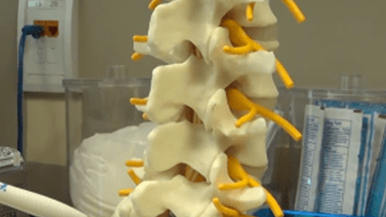- What is a Sacroiliac Injection?
- How is an SI Injection Performed?
- What Should You Expect After an SI Injection?
SI joint injections are predominantly employed to treat symptoms related to lower back pain, sciatica, and other sacroiliac dysfunction. The SI (sacroiliac) joint represents the source of pain in around 30% of all people who experience chronic lower back pain.
The SI joint is a large joint located in the lower part of the lumbar spine leading down into the buttocks, where the tailbone meets the pelvic bones on both sides of the spine. The SI joint does not possess a great degree of mobility; however, it absorbs much of the force from the upper body as weight is transferred to the hips and legs.As with any other joint in the body, through wear and tear and degeneration over time, arthritis can develop in the SI joint causing chronic pain and swelling. The discomfort can be felt in the immediate area of the SI joint, or it can resonate into other regions such as the hips, buttocks or thighs.
SI joint injections have the ability to pinpoint and reduce the pain associated with SI joint injury, arthritis, and dysfunction. The procedure is highly effective at diminishing inflammation and providing months of relief.What is a Sacroiliac Injection?

A sacroiliac joint injection is employed to both diagnose the source of pain and to improve symptoms of pain in the lower back.
How Does a Sacroiliac Injection Diagnose Pain?
A local anesthetic (typically lidocaine or bupivacaine) is injected into the SI joint using X-ray navigation, to corroborate a diagnosis of sacroiliac joint dysfunction by a pain management specialist. Before injecting the medication, a dye is released from the needle into the joint to assure correct needle placement and confirm the optimal spread of medicine. Then a small needle is targeted into each joint space to deposit the numbing medicine as accurately as possible. This is typically done in our state-of-the-art Fluoroscopy Suite.
If the patient obtains significant pain relief immediately after numbing (roughly 50%), it is highly likely the SI joint is the source of the pain.
How Can a Sacroiliac Injection Relieve Pain?
When the SI joint is the known and confirmed cause of pain and dysfunction, a therapeutic SI injection is performed. The process is identical to a diagnostic injection, with corticosteroid anti-inflammatory medication added to the injection to relieve swelling and provide pain relief.
Sustained relief of painful symptoms after the injection signals that the patient may begin physical therapy and rehabilitation to restore normal functioning and further dissipate any lingering discomfort. Therapeutic SI injections may be done up to four times annually as determined by your pain management physician.How is an SI Injection Performed?

The SI injection is a relatively simple process usually requiring no more than 15 minutes and is performed on an outpatient basis in our Fluoroscopy Suite, with patients able to return home shortly after the procedure.
To keep the patient as comfortable as possible during the procedure, local anesthetic is employed at the needle site. The skin over the SI joint will be cleaned and sterilized using antiseptic solution.
With the help of X-ray guidance, a tiny needle is placed into the joint to spread the contrast dye and to inject the anesthetic and cortisone medication gradually.What Should You Expect After an SI Injection?

Patients typically remain in the Fluoroscopy Suite for about half an hour after the injection to rule out any sudden complications or negative reactions, such as allergies or weakness in the legs.
Some people may experience sensitivity at the site of the injection for one to two days after the procedure. Ice may be used up to four times per day to help relieve any discomfort felt at the injection location.
There are minimal limitations after having an SI injection. Patients are asked not to soak the needle site in water, such as in a bathtub or in the ocean, for at least 24 hours after the procedure. Most patients resume their normal activities the following day.
Injected steroid medication can take anywhere between three to seven days to take full effect. Patients normally see their doctor for a follow-up visit about two weeks after the procedure, where the pain management physician will ascertain if there is anything else that can or needs to be done to provide additional pain relief.
